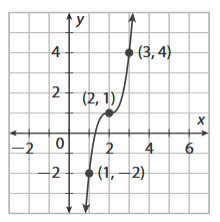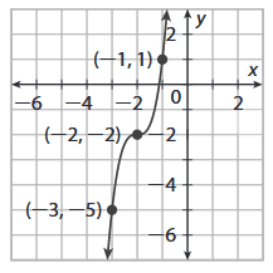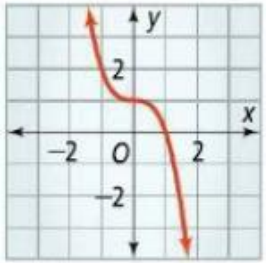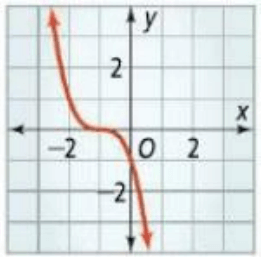HOW TO FIND THE EQUATION OF A CUBIC FUNCTION FROM GRAPH IN VERTEX FORM
Subscribe to our ▶️ YouTube channel 🔴 for the latest videos, updates, and tips.
Cubic functions can be sketched by transformation if they are of the form
f(x) = a(x - h)3 + k
where a is not equal to 0.
This does not represent the vertex but does give how the graph is shifted or transformed.
- The horizontal shift is given by the h.
- The vertical shift is given by the k.
Subscribe to our ▶️ YouTube channel 🔴 for the latest videos, updates, and tips.
Write a cubic function in the form
h(x) = a (x - h)3 + k
Problem 1 :

Solution :
By comparing the given graph with y = x3, we notice that the curve is moved
- horizontally 2 units to the right
- vertically 1 unit up.
So, h = 2 and k = 1
h(x) = a (x - 2)3 + 1
y = a (x - 2)3 + 1 ------(1)
The curve passes through the point (1, -2) and (3, 4)
Applying the point (1, -2)
-2 = a(1 - 2)3 + 1
-2 = a(-1)3 + 1
-2 = -a + 1
-a = -2 - 1
a = 3
Applying the value of a in (1), we get
y = 3 (x - 2)3 + 1
Problem 2 :

Solution :
By comparing the given graph with y = x3, we notice that the curve is moved
- horizontally 2 units to the left
- vertically 2 units down.
So, h = -2 and k = -2
h(x) = a (x - (- 2))3 + (-2)
h(x) = a (x + 2)3 - 2
y = a (x + 2)3 - 2 ------(1)
The curve passes through the point (-1, 1) and (-3, -5)
Applying the point (-1, 1)
1 = a(-1 + 2)3 - 2
1 + 2 = a(1)
a = 3
Applying the value of a in (1), we get
y = 3 (x + 2)3 - 2
Problem 3 :

Solution :
By comparing the given graph with y = x3, we notice that the curve is moved
- There is no horizontal movements.
- vertically 1 unit up.
So, h = 0 and k = 1
h(x) = a (x - 0)3 + 1
h(x) = a x3 + 1
y = a x3 + 1 ------(1)
The curve passes through the point (-1, 2) and (0, -1)
Applying the point (-1, 2)
2 = a(-1)3 + 1
2 = -a + 1
2 - 1 = -a
-a = 1
a = -1
Applying the value of a in (1), we get
y = -x3 + 1
Problem 4 :

Solution :
By comparing the given graph with y = x3, we notice that the curve is moved as follows.
- Horizontally moved 1 unit left.
- No vertical movements.
So, h = -1 and k = 0
h(x) = a (x - (-1))3 + 0
h(x) = a (x + 1)3
y = a (x + 1)3 ------(1)
The curve passes through the point (-2, 1) and (0, -1)
Applying the point (-2, 1)
1 = a (-2 + 1)3
1 = -a
a = -1
Applying the value of a in (1), we get
y = -1 (x - 1)3
Recent Articles
-
Finding Range of Values Inequality Problems
May 21, 24 08:51 PM
Finding Range of Values Inequality Problems -
Solving Two Step Inequality Word Problems
May 21, 24 08:51 AM
Solving Two Step Inequality Word Problems -
Exponential Function Context and Data Modeling
May 20, 24 10:45 PM
Exponential Function Context and Data Modeling